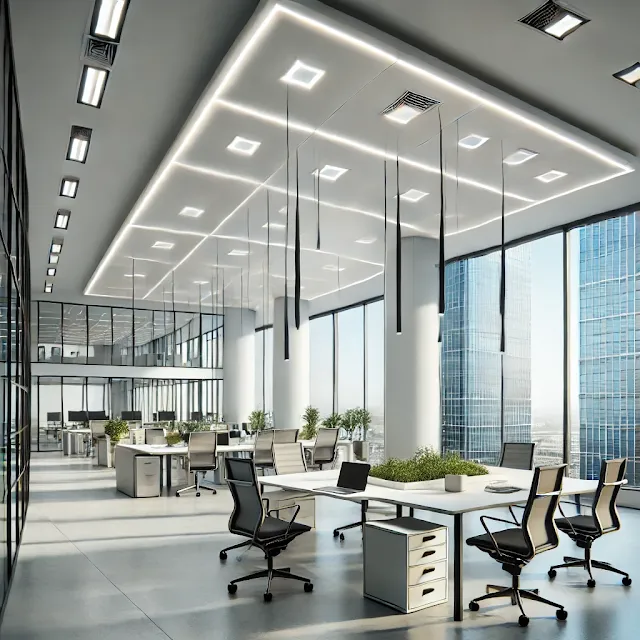1. Understanding Lighting Requirements
The first step in designing an LED lighting system is to assess the building’s lighting requirements. The total lighting requirement is usually expressed in terms of lumens, which measure the total visible light emitted by a light source. The lighting requirements for different areas of a building vary based on the purpose of the space. For example:
- Offices: Require 300 to 500 lux (lumens per square meter).
- Corridors: Require 100 to 150 lux.
- Warehouse or storage areas: Require 100 lux.
- Showrooms or retail areas: Require 500 to 700 lux.
2. Determining the Total Lumens Needed
To calculate the total lumens required for a room, multiply the area (in square meters) by the required lux level. For example, if you are lighting a 50 m² office space that requires 400 lux:
This calculation shows that the room requires 20,000 lumens to achieve proper illumination.
3. Selecting the Appropriate LED Lights
LED lights come in various wattages and lumen outputs. The luminous efficacy of an LED, which is the amount of light produced per watt of electricity consumed, typically ranges from 80 to 120 lumens per watt. To select the right LED lights, divide the total lumens required by the lumens per watt of the LED lights to get the total wattage needed.
For example, if you're using LEDs that provide 100 lumens per watt:
You could use either multiple low-wattage LEDs or a few high-wattage LEDs to meet the total wattage requirement. In this case, you could install ten 20-watt LED lights or four 50-watt LED lights.
4. Energy Consumption and Cost Savings Calculation
One of the main advantages of LED lighting systems is their energy efficiency. LEDs consume far less electricity than traditional lighting systems. To calculate the energy consumption of an LED lighting system, use the following formula:
Assume the lights are used for 10 hours per day, and there are 250 working days in a year. The annual energy consumption would be:
To compare with traditional incandescent bulbs, assume an incandescent system requires 1000W for the same lumens output:
In this example, the LED system consumes 500 kWh/year, while the incandescent system consumes 2500 kWh/year. This results in an annual energy savings of 2000 kWh. If the electricity rate is $0.12 per kWh, the cost savings would be:
5. Heat Emission Considerations
LED lights generate significantly less heat compared to incandescent or fluorescent bulbs, which reduces the cooling load on a building's HVAC (Heating, Ventilation, and Air Conditioning) system. In hot climates, this can lead to additional energy savings, as less air conditioning is required to maintain comfortable indoor temperatures.
For example, an incandescent bulb converts only 10% of energy into light, with the remaining 90% wasted as heat. By contrast, LEDs convert around 90% of energy into light and only 10% into heat.
6. Lighting Layout Design
The layout of the LED lighting system should ensure uniform light distribution without creating dark spots or excessive glare. Key considerations for layout design include:
- Spacing: The distance between LED fixtures should ensure even light distribution based on the beam angle and mounting height.
- Beam Angle: Choose the beam angle based on the desired light coverage. Narrow beam angles (25° to 45°) are suitable for focused lighting, while wider angles (60° to 120°) are ideal for general illumination.
- Height: The mounting height of the fixtures affects the spread of light. Higher mounting requires lights with higher lumen output or narrower beam angles.
Using lighting simulation software such as Dialux or Relux can help in optimizing the layout and achieving the desired light distribution.
7. Control Systems for Energy Efficiency
Adding control systems, such as dimmers, occupancy sensors, and daylight sensors, can further increase the energy efficiency of an LED lighting system. These systems ensure that lighting is only used when needed and at the appropriate brightness level.
- Dimmers: Allow users to adjust the brightness based on the time of day or specific tasks, reducing unnecessary energy use.
- Occupancy Sensors: Automatically turn lights on or off based on room occupancy, saving energy in areas like corridors, restrooms, and meeting rooms.
- Daylight Sensors: Adjust the brightness of artificial lighting based on available natural light, ensuring consistent illumination while minimizing energy consumption during daylight hours.
8. Maintenance and Lifespan of LED Systems
One of the greatest benefits of LED lighting systems is their long lifespan, typically ranging from 25,000 to 50,000 hours, compared to 1,000 to 2,000 hours for incandescent bulbs. This reduces maintenance costs, as the frequency of bulb replacements is significantly lowered. In a commercial setting, where lighting is in use for long hours, the reduced maintenance costs can lead to significant operational savings over time.
9. Case Study: LED Retrofit for a Commercial Building
Let’s consider a commercial building that previously used 100 incandescent bulbs, each consuming 60W. The total power consumption of the existing system was:
The building owner decided to retrofit the lighting system with 10W LED bulbs, which produce the same lumen output as the 60W incandescent bulbs. The new power consumption is:
With the lighting in use for 10 hours per day, the energy savings are calculated as follows:
- Incandescent Energy Consumption: 6000 W × 10 hours/day × 250 days/year = 15,000 kWh/year
- LED Energy Consumption: 1000 W × 10 hours/day × 250 days/year = 2500 kWh/year
This retrofit results in an annual energy savings of 12,500 kWh. At an electricity rate of $0.12 per kWh, the cost savings amount to $1,500 per year.
Conclusion
Designing energy-efficient LED lighting systems for buildings requires a detailed understanding of lighting requirements, power consumption, and system layout. By calculating the required lumens, selecting appropriate LED fixtures, and incorporating smart control systems, you can achieve significant energy savings while maintaining optimal lighting conditions. LEDs not only offer lower energy costs but also reduce heat emission and maintenance expenses, making them an ideal choice for sustainable building design.

